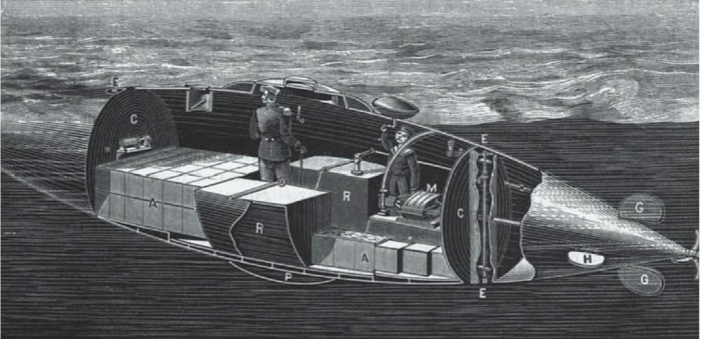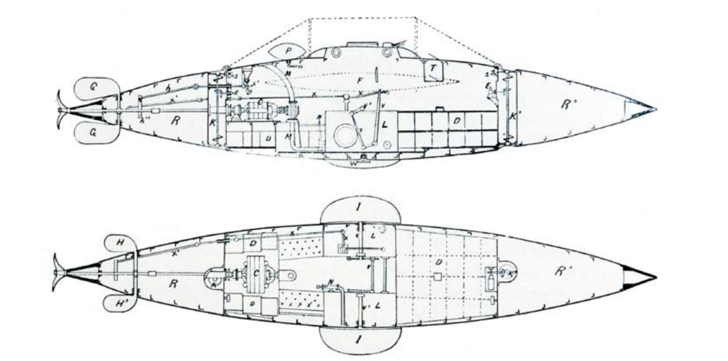
Iron electric submarine Porpoise, built J. F. Waddington, Seacombe, Wallasey, 1886.
37 ft long, 6 ft diameter.
6kW electric motor, 45 2-volt lead-acid batteries of 660 Ah each (total 60 kWh)
Eventually abandoned on shore near Wallasey, then scrapped.
Cochran's of Birkenhead constructed the Resurgam submarine in 1879 - which was subsequently lost under tow off the North Wales coast in 1880. James Franklin Waddington was an engineer with Cochran's - he decided to set up business himself, nearby at Seacombe, and build an electric submarine. He had the experience of building and testing the Resurgam - so was able to devise a well thought out plan for this new project. The main disadvantage of the Resurgam was the steam engine - the residual heat in the boiler (used for underwater propulsion) must have made conditions very unpleasant for her crew. Electric lead-acid accumulators (rechargeable batteries) were developed from 1857 and, by 1886, had reached a very useable state. The Electric Power and Storage Company of London was one of the pioneer manufacturers of lead-acid batteries.
Waddington's design was similar in appearance to the Resurgam though smaller (Resurgam had been 45 ft long and 10 ft diameter). He also used moveable side planes (at middle and rear) to stabilise the roll and attitude of the craft. An innovation was that he installed two vertical tubes (forward and rear) which had separate electric motors so that the craft could be stabilised (pitch) and also descend/rise. There was a single screw and a rudder to give propulsion and ability to turn. The vessel had ballast tanks, compressed air storage compartments, an electric water pump and a keel weight that could be jettisoned as a safety feature to regain the surface.
With 45 2-volt lead-acid accumulators of 660 ampere-hours capacity each - the vessel had a storage of 60 kWh. With a 6kW electric motor, this gave 10 hours (theoretical) running time. Maximum speed was 7knots. There was no provision for recharging - that relied on a mother vessel.
Sketch of the layout of Porpoise:

Plans of Porpoise:

From Liverpool Daily Post - Saturday 27 March 1886
A New Submarine Vessel. An electrical submarine vessel, which will prove
invaluable to submarine warfare, has been invented and designed by Mr. J.
F. Waddington, of Birkenhead, formerly of Clitheroe, and son of the Vicar
St. Paul's, Clitheroe, has recently been tried at this port with complete
success. The vessel which is cylindrical in shape, is about 37 feet long
overall, 6 feet diameter amidships, tapering to a point at each end. A conning
tower is placed on the top of the vessel, in the sides of which are
ports which enable the steersman to see in every direction, and which
is covered by a strong watertight scuttle for access to the interior of
the boat. The depth of the vessel below the surface of the water is
regulated by two inclined planes, one on each side, worked by a lever
amidships; and in addition there is rudder aft, worked by a self-acting
arrangement for keeping the vessel always in a horizontal position. The
interior fittings are so arranged that the boat may be worked by one
man, but the usual crew would two men. At each end of the boat is a
compartment for the storage of compressed air, which can be used when
the boat is kept below water for a lengthened period. At the same time, owing to the
absence of a boiler, fire, etc, there is sufficient air space for two men
to remain below water for six hours without drawing on the storage.
The motive power, electricity, is stored in fifty large accumulator
cells, which, when charged, are capable of driving the boat at the
speed of about nine miles an hour for ten hours, either at or beneath the
surface of the water, or at slow speed will drive her for about 250 miles
without re-charging. The motor drives the screw direct at about 800
revolutions per minute. This motor can also be coupled direct to a centrifugal
pump, which, in a few minutes, empties the water ballast tanks which
are used to submerge the vessel. The interior is lighted by incandescent
lamps, in addition to which there is a powerful electric search lamp on
the conning tower, which enables the steersman to see below water as well
as above. This is the most powerful installation of electrical power
ever fitted to any boat, and has been most successfully carried out by
Messrs. Ferry and Cox, of Liverpool. The storage cells being supplied by the
Electrical Power and Storage Company, London.
One of the chief advantages
claimed by the inventor is that a boat of this description can be carried
on the davits of any man-of-war, and the cells charged from the
dynamos whilst hanging on the davits. She is thus ready for use at once.
A further trial of this interesting vessel was made in the presence of
inspectors from the Admiralty on Wednesday [in West Float, Birkenhead], and proved most
successful. The Admiralty inspectors expressed themselves highly
satisfied with the results.
From London and China Express - Friday 20 January 1888 [inserted 1886-9]: Advert:
J F Waddington Seacombe: Submarine vessels, steam and electric launches, yachts etc.
Ship builders, marine and electrical engineers. High speed engines.
From Birkenhead News - Saturday 29 December 1888:
The following is a list of vessels launched during the year just
closing from the yard of Messrs. J. F. Waddington and Co., Seacombe: Sunbeam (25
gross tons register), Lukoju (20 tons), Euxine (180 tons)[ON 93816],
Sternwheeler (300 tons), Cruzierio (75 tons)[reached Para in Brazil in
September 1888], and Barge (50
tons).
Despite having demonstrated the craft successfully, Waddington was not able to sell Porpoise. He built other vessels: including Mersey Ferry Firefly (ON 93744) in 1887, and those listed above in 1888. His business was, however, declared bankrupt in August 1889. The shipyard was sold to recoup losses.
From Liverpool Journal of Commerce - Friday 13 September 1889:
By Order of the Official Receiver:
Re. J. F. Waddington. SHIPBUILDING YARD.
To Shipbuilders, Engineers, and Others
STOCK, PLANT, TOOLS, AND MISCELLANEOUS EFFECTS.
VERTICAL DRILLING MACHINE, Jib Cranes, Angle
Iron FURNACE, set of 8 Stocks and Dies, 6 heavy Anvils, 4 Tail 6in. Vices,
Sledge, Rivetting, and other Hammers, Smiths' Iron Hearths, Compound
Bellows, Iron Tongs, Swages, Fullers, Bolts, Nuts, Scrap Iron, Steel
and Iron Fittings, Drills, Punches, Grindstone, English Oak Logs,
Posts, Derricks, valuable assortment of Wood Patterns, principally
marine and other engines, Unfinished Materials, Paint, Varnish, Oil.
Ropes, Oakum, Iron Trucks, Work Benches, and Miscellaneous Fittings.
A WELL-BUILT SHED, 66ft long and 36ft wide, with corrugated iron roof
on strong columned supports, Staging,
OFFICE FURNITURE, Mahogany Desks, Arm Chairs, Copying Press, Tables, Cupboards, Draftsman's
Tables and Boards, Counters, Drawers, Stools, and Materials used in a
Shipbuilding Yard.
J. G. PARKER, SLOAN, and CO. will Sell by Auction, on
Tuesday next, the 17th inst., at Eleven o'clock in the Forenoon, at
the Seacombe Shipbuilding Yard, Seacombe, the above EFFECTS. To be
viewed on the day prior to the sale, when catalogues may be had at the
Yard, or from the Auctioneer, 7, Houghton-street. Further particulars
to be had from F. Gittins, Esq., Official Receiver, 26,
Victoria-street, Liverpool.